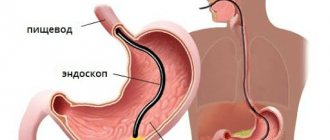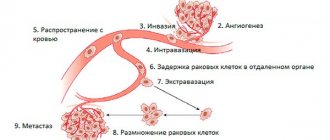Classification of gestosis
Depending on the origin, gestosis can be:
- Clean. It develops during normal health as an independent pathology. No other diseases are observed in the body of a pregnant woman before gestosis.
- Combined (combined). Occurs against the background of other diseases. Preeclampsia is especially severe in the presence of hypertension, pathologies of the kidneys, liver, endocrine and metabolic systems.
Preeclampsia develops in several stages. In modern gynecology, there are 4 stages of gestosis:
- Dropsy (edema). In the first stages of gestosis, hidden swelling appears. They are invisible visually, but their presence is indicated by an increase in body weight without objective reasons and a decrease in the amount of fluid during urination. Next, obvious swelling forms, which can already be seen. Neither hidden nor obvious edema should be attempted to be eliminated on your own - uncontrolled use of diuretics can harm both the expectant mother and the child. If swelling occurs, you should immediately seek medical help. Not all swelling is a symptom of gestosis, so there is no need to panic when they appear, but consultation with a doctor is required.
- Nephropathy (impaired kidney function). Observed during gestosis at approximately 20 weeks and later. Nephropathy is manifested by increased blood pressure, edema and the presence of protein in the urine. Malfunctions of the kidneys during gestosis can be minor, moderate or severe.
- Preeclampsia. In addition to the above-described manifestations of the disease, there is a disturbance in the blood supply to the brain and the functioning of the central system, which can be judged by the presence of headaches, nausea, vomiting, visual and mental disorders. This serious degree of gestosis is observed in approximately 5% of expectant mothers. More often it affects women who are pregnant for the first time.
- Eclampsia. The most severe degree of gestosis. In addition to the changes characteristic of the previous stages, seizures lasting 1-2 minutes are added. Attacks can be triggered by stress, pain, loud noises or bright lights. After them, the woman may lose consciousness. After the attack, the pregnant woman feels general malaise, weakness, and has a headache. However, she does not remember what happened to her. Jumps in blood pressure during eclampsia can be so severe that they can trigger a stroke.
The development of the disease can be either slow (up to several months, with mild manifestations - sometimes the pregnant woman does not even suspect the presence of pathology) or rapid.
How to cope with postpartum preeclampsia
The time after childbirth can be challenging even without health problems. Recovering from childbirth and caring for a newborn can be stressful. While recovering from pregnancy, it is important to pay attention to your own health by monitoring symptoms and consulting with your doctor.
If you are diagnosed with postpartum preeclampsia while in hospital, you may need a longer hospital stay. Reach out to loved ones or talk to your healthcare provider to learn about options for additional support when you return home.
Causes
The causes of preeclampsia and eclampsia have not yet been precisely established. There are 30 or more theories that explain the causes and mechanisms of development of preeclampsia and eclampsia. But the general opinion of all doctors is that there is a pathology of the placenta, the formation of which is disrupted in the early stages of pregnancy.
If the placental attachment is disrupted (superficially implanted placenta) or there is a deficiency of receptors for placental proteins, the placenta begins to synthesize substances that cause vasoconstriction (vasoconstrictors), which leads to a generalized spasm of all blood vessels in the body to increase pressure in them and increase the supply of oxygen and nutrients substances to the fetus. This leads to arterial hypertension and multiple organ damage (primarily the brain, liver, and kidneys are affected).
Heredity and chronic diseases play an important role in the development of preeclampsia and eclampsia.
Possible consequences of gestosis
In the absence of treatment or insufficient measures, gestosis can cause:
- complicated childbirth;
- placental abruption;
- child development delays;
- premature birth;
- pulmonary edema;
- heart or kidney failure in a pregnant woman;
- hemorrhages in a woman’s internal organs (liver, spleen, intestines, kidneys, pancreas, etc.);
- death of the fetus (in especially severe cases of eclampsia - and of the mother).
Diagnostics
Differential diagnosis of preeclampsia and eclampsia must first be carried out with an epileptic seizure (“aura” before the attack, convulsions). Also, these complications should be distinguished from uremia and brain diseases (meningitis, encephalitis, hemorrhages, neoplasms).
The diagnosis of preeclampsia and eclampsia is established based on a combination of instrumental and laboratory data:
- Blood pressure measurement. Increasing blood pressure to 140/90 and maintaining these numbers for 6 hours, increasing systolic pressure by 30 units and diastolic by 15.
- Proteinuria. Detection of 3 or more grams of protein in the daily amount of urine.
- Blood chemistry. An increase in nitrogen, creatinine, urea (kidney damage), an increase in bilirubin (red blood cell breakdown and liver damage), an increase in liver enzymes (AST, ALT) - liver dysfunction.
- General blood analysis. An increase in hemoglobin (a decrease in the volume of fluid in the vascular bed, that is, blood thickening), an increase in hematocrit (viscous, “stringy” blood), a decrease in platelets.
- General urine analysis. Detection of protein in urine in large quantities (normally absent), detection of albumin (severe preeclampsia).
What are the prerequisites for the development of preeclampsia in each specific pregnant woman?
We doctors call these prerequisites risk factors. The more risk factors a pregnant woman has, the higher her likelihood of developing PE becomes. These are the factors:
- late reproductive age of the mother;
- overweight;
- Afro-Caribbean and South Asian ethnicities;
- a history of chronic arterial hypertension, diabetes mellitus, systemic lupus erythematosus, anti-phospholipid syndrome;
- pregnancy resulting from the use of assisted reproductive technologies (IVF);
- presence of a family or personal history of PE.
We also note that the risk of PE in primigravidas is three times higher than in multigravidas with uncomplicated previous pregnancies. Women who have PE during their first pregnancy have a tenfold risk of developing PE in their next pregnancy. The risk of PE is lower in tall women than in short women and is reduced in parous women with no history of PE in a previous pregnancy. If the interval between previous and current pregnancies is > 15 years, the risk of developing PE becomes equivalent to that of nulliparous women. We see that PE can also occur in a primigravid woman who, before pregnancy, did not know that she had any diseases or conditions that could lead to the development of PE.
Prevention of gestosis
The main preventive measure is pregnancy planning. Before conceiving, a woman must undergo medical examinations and cure any identified diseases. It is also important to register before the 12th week of pregnancy and visit a gynecologist in a timely manner.
The expectant mother needs to sleep at least 8 hours a day, monitor her diet (avoid salty, smoked, fatty and canned foods), try to avoid stressful situations, spend enough time in the fresh air every day and pay attention to moderate physical activity.
Why does eclampsia occur?
There is no exact data on the causes of gestosis. There are several theories that partially explain it. According to the first version, the development of gestosis is caused by genetic disorders of the woman’s body’s adaptation to pregnancy. The second says that the root cause of gestosis is endocrine disorders. In addition, heredity is of great importance in this case. The risk of developing such a pathology is much higher in those women in whose family a mother, grandmother or sister suffered from gestosis.
The risk of eclampsia is aggravated in the presence of untreated chronic foci of infection located in and outside the organs of the reproductive system, as well as in the presence of serious psychological problems.
Preparing for a future pregnancy
If you had preeclampsia during pregnancy or postpartum preeclampsia, you are at high risk of complications in future pregnancies. But it is possible that you will not have complications during your next pregnancy. Your doctor will likely monitor you more closely throughout your future pregnancy for signs of complications.
Your doctor may also recommend preventative treatment to reduce the risk of complications
Translation by Svetlana Sheremeteva
Photos from free sources
Symptoms
Signs of eclampsia that indicate an imminent seizure:
- proteinuria (the presence of protein compounds in the urine of a pregnant woman);
- weakness and fatigue;
- the formation of edema on the pregnant woman’s body;
- increase in blood pressure;
- slight impairment of visual function;
- nausea and vomiting not provoked by other reasons.
Symptoms of eclampsia:
- loss of consciousness by a pregnant woman for a certain period of time;
- small muscle contractions;
- clonic convulsions, as well as tonic;
- the skin acquires a blue tint;
- eclamptic coma.
An attack of eclampsia can occur either once (long-term) or several times (short-term attacks).









